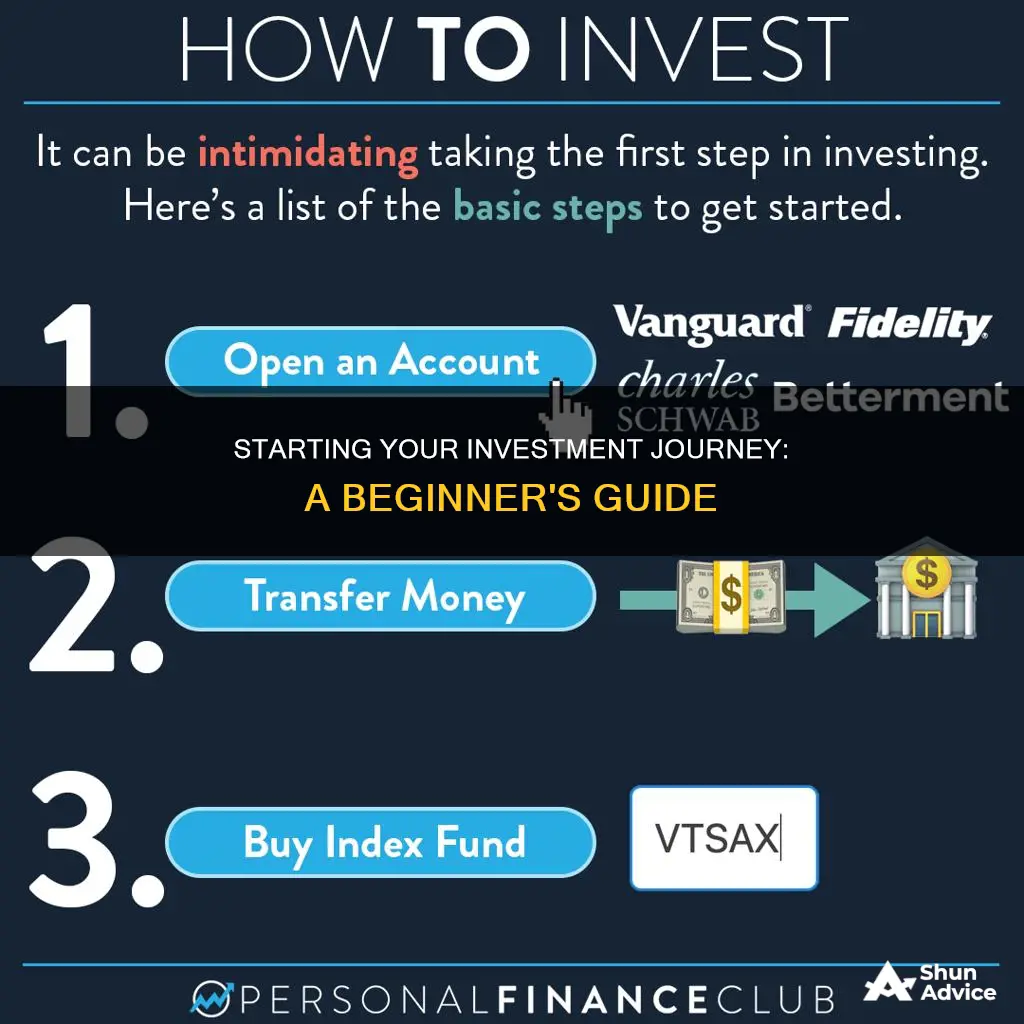
Investing is a great way to build wealth and save for the future. It can be intimidating for beginners, but with the right tools and knowledge, anyone can start investing and work towards their financial goals. Before making any investment, it's important to understand your risk tolerance and financial goals. There are many different investment options available, from stocks and bonds to mutual funds and exchange-traded funds (ETFs). It's crucial to do your research, set clear goals, and determine how much you can afford to invest. Additionally, choosing the right type of investment account, such as a brokerage account or a tax-advantaged account, is essential. By following these steps and staying informed, beginners can confidently enter the world of investing and work towards their financial goals.
| Characteristics | Values |
|---|---|
| Investment goals | Clear, specific, ranked by priority |
| Investment amount | Based on income sources, emergency fund, debts, and budget |
| Risk tolerance | Based on comfort with market volatility, time horizon, and financial cushion |
| Investment style | DIY, professional guidance, or robo-advisory |
| Investment account type | Brokerage, retirement, managed, dividend reinvestment, education, or health savings |
| Investment account features | Tax implications, fees, minimums, automatic contributions, educational resources, user-friendly platform, customer service, and security |
| Broker type | Full-service, discount, or robo-advisory |
| Broker features | Financial services, educational materials, low thresholds, and trading options |
| Investment funding | Bank transfer, check deposit, transfer from another brokerage, or automatic contributions |
| Investment type | Blue-chip stocks, dividend stocks, growth stocks, defensive stocks, ETFs, index funds, mutual funds, or quality factor ETFs |
What You'll Learn

Set clear investment goals
Setting clear investment goals is the first step in investing. It is important to be specific about your objectives, such as "accumulate $500,000 in my retirement fund by age 50", instead of a vague goal like "save for retirement". This clarity will help you navigate the stock market with confidence and purpose.
Your investment goals should consider both your short-term and long-term objectives. For example, saving for a home or a vacation are short-term goals, while securing a comfortable retirement or funding a child's education are long-term goals. The more precise you are, the better.
It is also important to assess how long you have to achieve each goal. Longer time horizons often allow for more aggressive investment strategies, while shorter ones may require a more conservative approach. For instance, younger investors tend to focus more on growth and long-term wealth accumulation, while those closer to retirement typically prefer generating income and capital preservation.
It is crucial to be realistic about how much you can put toward your investment goals, considering your savings, regular income, and any other financial resources. Ranking your goals based on urgency and importance will help you prioritize your investments. For example, saving for a down payment on a house might take precedence over planning a vacation.
Remember, financial planning is an ongoing process that should evolve with your needs and aspirations. Regularly review and adjust your goals as your life circumstances change.
Building a Robust Investment Portfolio at 50
You may want to see also

Decide how much to invest
Deciding how much to invest is a crucial step in your investment journey. Here are some detailed guidelines and tips to help you determine the appropriate amount to invest:
Assess Your Financial Situation:
Start by evaluating your income sources, savings, regular expenses, and any other financial commitments. This will help you understand how much money you can comfortably set aside for investing. It's important to ensure that your investments don't jeopardise your financial stability.
Create an Emergency Fund:
Before allocating money for investing, make sure you have a solid financial cushion. Set aside enough money to cover unexpected expenses and maintain your essential bills for a few months. This will provide you with a safety net in case of financial emergencies.
Pay Off High-Interest Debts:
Prioritise paying off any high-interest debts, such as credit card balances. The interest accumulating on these debts can outweigh the potential returns from your investments. Therefore, focus on clearing these debts first to improve your overall financial health.
Set Clear Investment Goals:
Be specific about your financial objectives. Define both short-term and long-term goals, as they will influence your investment strategy. For example, you might be saving for a house down payment, planning for retirement, or aiming to invest in your child's education. Prioritise your goals based on their urgency and importance.
Determine Your Investment Horizon:
Consider how long you have until you need to achieve each investment goal. Longer time horizons often allow for more aggressive investment strategies, while shorter-term goals may require a more conservative approach. Understanding your investment timeline will help guide your risk tolerance and investment choices.
Calculate the Required Amount:
For each investment goal, estimate the amount of money you will need to achieve it. This will give you a target to work towards and help you determine how much to invest regularly. You can use online calculators or seek professional advice to get a more precise estimate.
Start Small and Increase Gradually:
If you're just starting, don't feel pressured to invest a large sum all at once. Start with an amount that feels manageable and aligns with your financial situation. You can always increase your investment contributions over time as you gain more experience and confidence.
Take Advantage of Employer Matching:
If you have access to a workplace retirement plan, such as a 401(k), contribute at least enough to take full advantage of any employer matching funds. This is essentially free money that can boost your retirement savings significantly.
Consider Your Risk Tolerance:
Understanding your risk tolerance is crucial in deciding how much to invest. Reflect on your comfort level with market volatility. Are you willing to take on higher risks for potentially higher returns, or do you prefer stability? Your risk tolerance will influence the types of investments you choose.
Review Your Progress Regularly:
Investing is a long-term journey, and it's important to monitor your progress. Check in on your investments periodically to ensure they align with your original plan. Make adjustments as necessary, especially after major life events or changes in your financial situation.
Becoming an Investment Operations Manager: Skills and Strategies
You may want to see also

Understand your risk tolerance
Understanding your risk tolerance is a critical step in making your first investment. Risk tolerance refers to the amount of financial risk you are comfortable taking on, and it is influenced by various factors, including your investment goals, time horizon, reliance on invested funds, and inherent personality. Here are some essential considerations to help you assess your risk tolerance:
Investment Goals
The first step in understanding your risk tolerance is to define your investment goals. Ask yourself why you are investing. Common goals include saving for retirement, funding your child's education, or achieving financial independence. Determining your investment goals will help you assess how much risk you are willing to take on. For example, if your goal is to preserve capital or protect your existing assets, you may choose lower-risk investments that may result in lower growth. On the other hand, if your goal is aggressive growth, you may be willing to take on more risk.
Time Horizon
The time horizon for your investments is also a crucial factor in determining your risk tolerance. Generally, if you have a long-term investment horizon, such as saving for retirement, you can afford to take on more risk. Historical data shows that the stock market tends to recover from downturns over more extended periods, so you have a better chance of riding out the volatility. Conversely, if you have a shorter time horizon, such as saving for a down payment on a house, you may need to be more conservative in your investment approach to avoid potential losses.
Reliance on Invested Funds
Consider whether the money you are investing is essential for your immediate or future needs. For example, is it intended for a home down payment, your child's education, or is it disposable income that you can afford to lose? If you rely on this money for essential expenses, you may want to be more cautious in your investment choices to avoid significant losses.
Personality
Your inherent personality traits also play a role in your risk tolerance. Some people are naturally more cautious and risk-averse, while others are adventurous and comfortable with taking risks. While your risk capacity may be technically higher, it is essential to consider your comfort level with potential losses. If the idea of losing money makes you anxious, you may want to opt for more conservative investments to avoid early withdrawals due to market volatility.
Financial Ability
Your financial ability to take on risk is just as important as your willingness. Assess your financial circumstances, including your income, net worth, and short-term and long-term spending requirements. If you have a stable income and a healthy financial cushion, you may be more comfortable taking on higher-risk investments. However, if your income is lower or less predictable, you may prefer safer investments to preserve your capital and avoid financial strain.
By considering these factors, you can gain a clearer understanding of your risk tolerance. This knowledge will help you make informed investment decisions, choose suitable investments, and build a portfolio aligned with your financial goals and comfort level. Remember, risk tolerance is unique to each individual, and it may evolve over time as your goals, financial situation, and time horizon change.
Japan's Equity Market: Why You Should Invest Now
You may want to see also

Choose an investment account
There are several types of investment accounts, each with its own purpose. Here are some of the most common ones:
- Standard brokerage account: This type of account provides access to a broad range of investments, including stocks, mutual funds, bonds, and exchange-traded funds. Any interest, dividends, or gains on investments sold are subject to taxes in the year they are received. You can choose between an individual or joint taxable brokerage account. A cash account is generally recommended for most investors, while a margin account is for those who want to borrow money from the broker to invest.
- Retirement accounts: These include traditional and Roth IRAs, as well as employer-sponsored plans such as 401(k)s. The main difference between retirement and brokerage accounts lies in how contributions, investment gains, and withdrawals are taxed. Retirement accounts typically have higher contribution limits, and some employers match a portion of the contributions.
- Investment accounts for kids: Examples include custodial brokerage accounts, such as UGMA and UTMA accounts, which are set up for minors with money gifted to them. The adult custodian maintains control and transfers the assets when the child reaches the "age of majority" (18 or 21, depending on the state). Another option is a Roth or traditional IRA for children with earned income.
- Education accounts: 529 savings plans and Coverdell Education Savings Accounts (ESAs) are two examples. They are used to save for education expenses, including college, elementary, and secondary education. ABLE accounts are similar but designed specifically for individuals with disabilities, offering tax-advantaged savings without affecting access to public benefits.
Duke Energy's Investment Decision-Making: Strategy and Factors
You may want to see also

Pick an investment strategy
Picking an investment strategy is a crucial step in making your first investment. Here are some detailed guidelines to help you choose an investment strategy that aligns with your goals and risk tolerance:
Determine Your Risk Tolerance:
Before deciding on an investment strategy, it is essential to understand your risk tolerance. Ask yourself how comfortable you are with the inherent volatility of the stock market. Are you willing to take on higher risks for potentially greater returns, or do you prefer stability, even if it means potentially lower returns? Your risk tolerance will guide the types of investments you choose.
Identify Your Investment Goals:
Clearly define your financial objectives, including both short-term and long-term goals. For example, you might be saving for a home, planning for retirement, or investing for your child's education. The more specific and precise you are with your goals, the better. This clarity will help you make informed investment decisions.
Assess Your Investment Horizon:
Consider the time horizon for each of your investment goals. Do you need the money in the short term (less than five years), medium term (one to five years), or long term (more than five years)? Generally, longer investment horizons allow for more aggressive strategies, while shorter horizons may require a more conservative approach to ensure capital preservation.
Choose Your Investment Style:
Decide whether you prefer a hands-on or passive investment strategy. If you opt for a DIY approach, you can choose between active investing, where you actively manage your trades, or passive investing, where you buy shares in index funds or ETFs. Alternatively, you may prefer to seek professional guidance from a broker or financial advisor, especially if you want a more personalised approach.
Diversify Your Portfolio:
Diversification is a key aspect of risk management in investing. Diversifying your portfolio means spreading your investments across different asset classes, sectors, and industries. This helps to reduce the overall risk of your portfolio because different assets tend to perform differently in various market conditions. The three main asset classes are stocks, bonds, and cash. Stocks typically offer the highest potential for gains but also carry the most risk. Bonds are considered less risky and can provide income, while cash and cash equivalents provide flexibility and stability.
Monitor and Review:
Investing is an ongoing process that requires regular monitoring and adjustments. Stay informed about the global economy, industry trends, and the companies you invest in. Review your investment portfolio periodically to ensure it aligns with your goals and risk tolerance. Make changes as necessary, especially after major life events or shifts in your financial situation.
Remember, investing carries inherent risks, and there is always the potential for losses. It is important to carefully consider your risk tolerance, financial goals, and time horizon before choosing an investment strategy.
Growth Equity: Smart Investment for Long-term Business Success
You may want to see also
Frequently asked questions
You can start investing with just a few hundred dollars. There are no longer large investment minimums, and fractional shares allow you to invest in stocks with a small budget.
Some good investment options for beginners include high-yield savings accounts, certificates of deposit (CDs), 401(k) plans, mutual funds, exchange-traded funds (ETFs), and individual stocks.
Look for stocks that offer stability and a strong track record. As a beginner, you should consider blue-chip stocks, dividend stocks, defensive stocks, and ETFs.
The type of investment account you choose depends on your goals. If you're investing for retirement, a 401(k) or IRA is a good option. For short-term goals, a standard brokerage account is better. Compare different brokers and account types to find the best fit for your needs.
First, set clear investment goals and determine how much you can afford to invest. Then, choose an investment account and fund it through a bank transfer, check deposit, or transfer from another brokerage. Finally, start investing by choosing stocks or other assets that align with your goals and risk tolerance.







